MEMBERSHIP EXCLUSIVE OFFERS
During the early period of the pandemic lockdown in Great Britain in 2020 I took the opportunity of my enforced idleness to explore my LP collection. I bought a new turntable and set too, listening to a variety of LPs. In my Sibelius collection I discovered three that I had long neglected:
Koussevitzky conducting the Boston Symphony Orchestra:
Symphonies Nos 1 (recorded on 13/10/45) and 7 (recorded on 20/4/46)
Symphonies Nos 5 (recorded on 5/1/46) and 6 (recorded on 9/3/46).
These were from live broadcasts, issued on the Rococo Label. They perhaps represent some differences of view set down by the great Sibelius champion to his other performances largely represented by his various commercial recordings. Taken on the wing so to speak they show Koussevitzky in great form in front of live and home audiences declaring his love and admiration for Sibelius.
Antero Saike conducting the Symphony Orchestra of Olympia:
Symphony No.7
Karelia Suite
Issued by Allegro Elite label. After a number of listens to this LP I became intrigued as to how such an interesting performance could be performed by an unknown conductor and orchestra. After lots of investigations on line I was pretty certain this LP was, in fact, a recording made by Nils-Eric Fougstedt with his then Finnish Radio Symphony Orchestra. The coupling was incorrect. It was music from Pelléas et Mélisande. This helped to validate the real participants due to the knowledge that this programme was broadcast on Finnish radio in 1953 and the authority heard in the playing and conducting could logically have come from a Finnish maestro at that time. My investigations pointed to a common practice in America in the 1950’s of copyright deceit by cheap American LP labels to circumvent European laws. This was done widely by inventing non-existing conductors, soloists and orchestras thereby saving a fortune on fees etc. I sought advice from a number of respected music lovers with knowledge of this practice and we all concluded the LP I had was indeed by the Finnish performers as above. The importance of this conclusion became more and more evident to me. By 1953 there were no recordings of the Seventh Symphony made by Finnish conductors and so we had no evidence of a performing tradition in this last symphony by Sibelius. Sibelius was still alive and well and would likely to have made his views known on performances he heard, at least over time. So answers to questions we all seek in this one movement masterpiece, such as tempi relationships, dynamics, balances etc could be heard for the first time from a conductor for whom Sibelius had a high respect. One question has always hung over this work. How long should it take to conduct? With the plethora of recordings now available we can hear durations ranging from 16+ minutes to over 24 minutes. This is amazing in such a short work. Maestro Fougstedt takes just over 18 minutes which is shorter to performances we hear today, normally over 20 minutes.
Since our issuing this recording a new historic broadcast of the Seventh Symphony has been issued on the Pristine label of a live performance from New York in 1939. This is a concert conducted by Georg Schnéevoigt with the NBC Symphony Orchestra in Symphonies Nos 2 and 7 plus the world premiere of two of the Lemminkäinen Legends in their revised versions made shortly earlier by Sibelius. This might have thrown new light on, at least, how long another Finnish conductor took in the Seventh Symphony before Sibelius’s death in 1957. Alas the early part of the work is omitted as the announcer’s introduction took precedence over the start of the performance! So we remain with the guidance from Nils-Eric Fougstedt for some sense of how the Seventh was conducted in the era of Sibelius’s lifetime, both in time and content.
Coupled with the Fougstedt recordings is a rare Decca recording of the popular Violin Concerto, made by Janine Andrade again supported by Fougstedt and his Finnish Radio Symphony Orchestra. I had long cherished hearing, let alone owning, this 10” LP and my incarceration at home gave me plenty of time to figure out how to achieve this! I tracked the availability down to a German based web site and paid the required price like a shot. It was too good to miss. My note on the CD explains the career of Madame Andrade and her sad demise and subsequent early death. Not only is this the only known CD version of her performance it is also one to cherish from a contemporary of the better-known French virtuoso, Ginette Neveu, who also tragically met her early death in a plane crash. Her recording of the Sibelius Concerto has been famous since its issue in 1947.
Our thanks go to Mark Obert-Thorn, one of the finest and most respected re-mastering specialists in the world. Also to Paul Terry for his support and insights into the delivery of these historic and rare recordings
More recently the Society has been able to issue another invaluable CD taken from broadcasts in the 1940’s by a doyen of Sibelius interpretation, Armas Järnefelt, Sibelius’s brother-in-law no less. Again we hear many examples in early performance tradition in both Symphonies Nos 2 and 6. Both are faster than we normally hear today, the Second markedly so.
Our thanks go to Roger Smithson and Paul Terry for their guidance and support as to availability and production of this remarkable CD.
TWO BOOK OFFERS
These two books come from very contrasting backgrounds. Santeri Levas was Sibelius’s long time Secretary up to his death in 1957. He offers unique insights into Sibelius by recording conversations and many aspects of life in the Sibelius household over many years. My own book offers reflections based on a deep love for this wonderful composer, spread over sixty years of knowing his life and works, beginning at school through to my on-going retirement.
CD OFFERS
During the early period of the pandemic lockdown in Great Britain in 2020 I took the opportunity of my enforced idleness to explore my LP collection. I bought a new turntable and set too, listening to a variety of LPs. In my Sibelius collection I discovered three that I had long neglected:
Koussevitzky conducting the Boston Symphony Orchestra:
Symphonies Nos 1 (recorded on 13/10/45) and 7 (recorded on 20/4/46)
Symphonies Nos 5 (recorded on 5/1/46) and 6 (recorded on 9/3/46).
These were from live broadcasts, issued on the Rococo Label. They perhaps represent some differences of view set down by the great Sibelius champion to his other performances largely represented by his various commercial recordings. Taken on the wing so to speak they show Koussevitzky in great form in front of live and home audiences declaring his love and admiration for Sibelius.
Antero Saike conducting the Symphony Orchestra of Olympia:
Symphony No.7
Karelia Suite
Issued by Allegro Elite label. After a number of listens to this LP I became intrigued as to how such an interesting performance could be performed by an unknown conductor and orchestra. After lots of investigations on line I was pretty certain this LP was, in fact, a recording made by Nils-Eric Fougstedt with his then Finnish Radio Symphony Orchestra. The coupling was incorrect. It was music from Pelléas et Mélisande. This helped to validate the real participants due to the knowledge that this programme was broadcast on Finnish radio in 1953 and the authority heard in the playing and conducting could logically have come from a Finnish maestro at that time. My investigations pointed to a common practice in America in the 1950’s of copyright deceit by cheap American LP labels to circumvent European laws. This was done widely by inventing non-existing conductors, soloists and orchestras thereby saving a fortune on fees etc. I sought advice from a number of respected music lovers with knowledge of this practice and we all concluded the LP I had was indeed by the Finnish performers as above. The importance of this conclusion became more and more evident to me. By 1953 there were no recordings of the Seventh Symphony made by Finnish conductors and so we had no evidence of a performing tradition in this last symphony by Sibelius. Sibelius was still alive and well and would likely to have made his views known on performances he heard, at least over time. So answers to questions we all seek in this one movement masterpiece, such as tempi relationships, dynamics, balances etc could be heard for the first time from a conductor for whom Sibelius had a high respect. One question has always hung over this work. How long should it take to conduct? With the plethora of recordings now available we can hear durations ranging from 16+ minutes to over 24 minutes. This is amazing in such a short work. Maestro Fougstedt takes just over 18 minutes which is shorter to performances we hear today, normally over 20 minutes.
Since our issuing this recording a new historic broadcast of the Seventh Symphony has been issued on the Pristine label of a live performance from New York in 1939. This is a concert conducted by Georg Schnéevoigt with the NBC Symphony Orchestra in Symphonies Nos 2 and 7 plus the world premiere of two of the Lemminkäinen Legends in their revised versions made shortly earlier by Sibelius. This might have thrown new light on, at least, how long another Finnish conductor took in the Seventh Symphony before Sibelius’s death in 1957. Alas the early part of the work is omitted as the announcer’s introduction took precedence over the start of the performance! So we remain with the guidance from Nils-Eric Fougstedt for some sense of how the Seventh was conducted in the era of Sibelius’s lifetime, both in time and content.
Coupled with the Fougstedt recordings is a rare Decca recording of the popular Violin Concerto, made by Janine Andrade again supported by Fougstedt and his Finnish Radio Symphony Orchestra. I had long cherished hearing, let alone owning, this 10” LP and my incarceration at home gave me plenty of time to figure out how to achieve this! I tracked the availability down to a German based web site and paid the required price like a shot. It was too good to miss. My note on the CD explains the career of Madame Andrade and her sad demise and subsequent early death. Not only is this the only known CD version of her performance it is also one to cherish from a contemporary of the better-known French virtuoso, Ginette Neveu, who also tragically met her early death in a plane crash. Her recording of the Sibelius Concerto has been famous since its issue in 1947.
Our thanks go to Mark Obert-Thorn, one of the finest and most respected re-mastering specialists in the world. Also to Paul Terry for his support and insights into the delivery of these historic and rare recordings
More recently the Society has been able to issue another invaluable CD taken from broadcasts in the 1940’s by a doyen of Sibelius interpretation, Armas Järnefelt, Sibelius’s brother-in-law no less. Again we hear many examples in early performance tradition in both Symphonies Nos 2 and 6. Both are faster than we normally hear today, the Second markedly so.
Our thanks go to Roger Smithson and Paul Terry for their guidance and support as to availability and production of this remarkable CD.
TWO BOOK OFFERS
These two books come from very contrasting backgrounds. Santeri Levas was Sibelius’s long time Secretary up to his death in 1957. He offers unique insights into Sibelius by recording conversations and many aspects of life in the Sibelius household over many years. My own book offers reflections based on a deep love for this wonderful composer, spread over sixty years of knowing his life and works, beginning at school through to my on-going retirement.
CDs
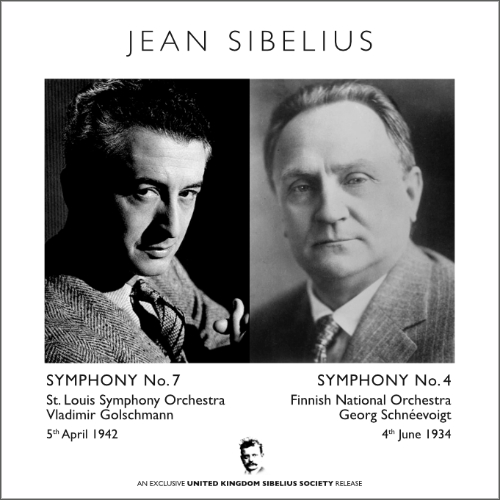
Schnéevoigt & Golschmann – Symphonies 4&7
Schnéevoigt & Golschmann – Symphonies 4 & 7 | £10
Two extraordinary recordings
Symphony 4 conducted by Georg Schnéevoigt. Finnish National Orchestra (Live 1934)
Symphony 7 conducted by Vladimir Golschmann. St. Louis Symphony Orchestra (1942)
These two Sibelius Symphony recordings, of Nos 4 and 7 on this Society CD are among the most intense of any I know. Georg Schnéevoigt and Vladimir Golschmann are not house-hold names today but both were noted interpreters of 20th century music in the 1930’s and 40’s. No. 4 comes from a live performance in London in 1934 and No. 7 from a commercial recording in St Louis, America in 1942.
The CD has a note written by Edward Clark
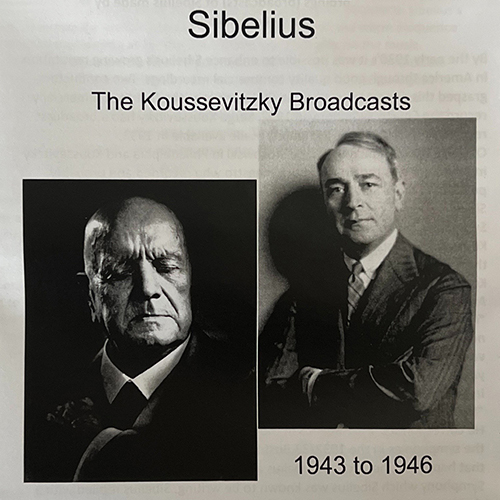
Koussevitzky Broadcasts 1943–46
Koussevitzky Broadcasts 1943–46 | £10
Serge Koussevitzky was one of Sibelius’s greatest American champions and much admired by Sibelius. These two CDs contain broadcast performances from concerts held in Boston during the 1940’s and allow us to hear Koussevitzky live in concert compared to his better-known recordings in the studio. The performance of the Sixth Symphony is very rare.
The CD has a note written by Edward Clark
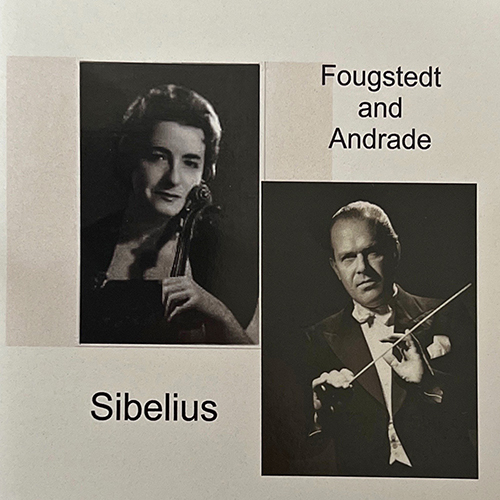
Fougstedt and Andrade
Fougstedt and Andrade | £10
Pelléas et Mélisande Suite (extracts)
Symphony No.7
Violin Concerto with Janine Andrade
Nils-Eric Fougstedt was a favoured Finnish conductor of Sibelius’s music. The Pelléas et Mélisande Suite extracts and the Seventh Symphony were broadcast in 1953. The Violin Concerto was released on a 10” Decca LP c. 1959. It did not have wide circulation in Europe. It is now a collectors’ item and has great rarity value.
The soloist was Janine Andrade, one of a number of French female violinists whose careers flourished after the end of the war. One of her contemporaries was Ginette Neveu, whose recording of the Sibelius concerto in 1946 became widely admired. Neveu died in a plane crash in 1949. Andrade’s career won critical praise until a catastrophic stroke in 1972 brought an end to her public life. She spent the last years of her life in a nursing home and she died in 1997.
The Seventh Symphony recording is the only preserved performance by a Finnish conductor which represents the Finnish performance tradition in this work before Sibelius died in 1957. There are no recordings by Robert Kajanus, Tauno Hannikainen, Armas Järnefelt or Georg Schnéevoigt. It is, therefore, an important addition to the early recording history of this late work.
The remastering transfers onto CD from the original LPs have been done by Mark Obert Thorn.
The CD has a note written by Edward Clark
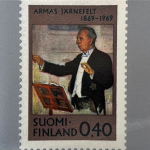
Järnefelt conducts Symphs. 2 & 6
Armas Järnefelt conducts | £10
Symphonies Nos 2 & 6
Armas Järnefelt was a composer and conductor who introduced Richard Wagner’s operas into Finland and who is known for his works for small orchestra.
He studied under Busoni in Helsinki and Massenet in Paris. His early career was in Finland, giving the first performances of Wagner’s operas in Finland. He was appointed conductor of the Royal Opera in Stockholm in 1907 and in 1910 became a naturalised Swedish citizen. In 1932 he returned to Finland as director of the Helsinki Opera. He wrote songs and choral, orchestral and piano music but became best known for his Berceuse (1904) and Praeludium (1900) for small orchestra.
Today he is best known for being Sibelius’s brother-in-law; his sister, Aino married Sibelius. He conducted Sibelius throughout his career but left few recordings, the best known is of the Violin Concerto with Anja Ignatius, recorded in Berlin in 1943. The two recordings on our new society CD are of symphonies 2 and 6.
The Second symphony comes from a concert broadcast made on Sibelius’s 80th birthday, the 8th December 1945. It was to be Järnefelt’s last concert, which makes the performance so moving and poignant. Also, it is one of the finest and most interesting interpretations ever to be heard.
The Sixth Symphony comes from a Finnish radio broadcast made in the Helsinki University Hall on the 18th April 1941. It is a performance that illuminates the poetry behind the notes of this enigmatic score.
Details of the orchestras and original sources are included in the CD notes.
BOOKS
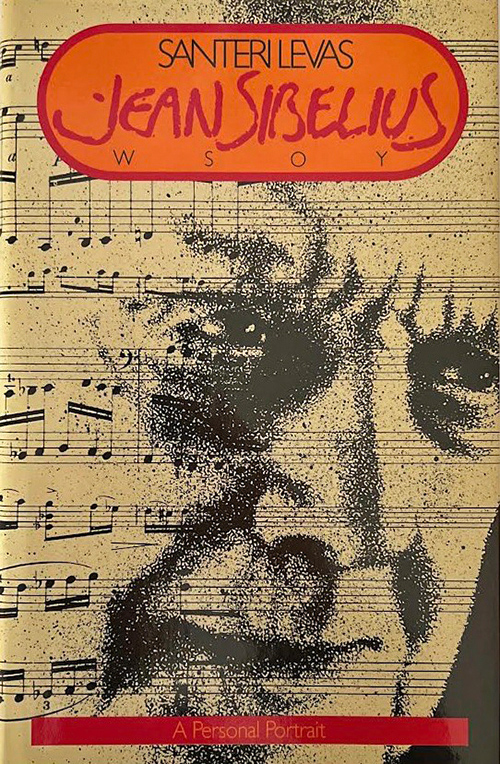
Jean Sibelius by Santeri Levas
Jean Sibelius | £10
By Santeri Levas
In 1938 the author was appointed secretary to Jean Sibelius and worked for him for nearly 20 years until the death of the composer in 1957. During this period Levas made notes about his conversations with Sibelius and about life in all its aspects at Ainola, the home of the Sibelius family. The book contains unique insights into Sibelius’s many musical and non-musical interests. Much of the writing is conversational in tone, recording Sibelius’s words and thoughts on many subjects.
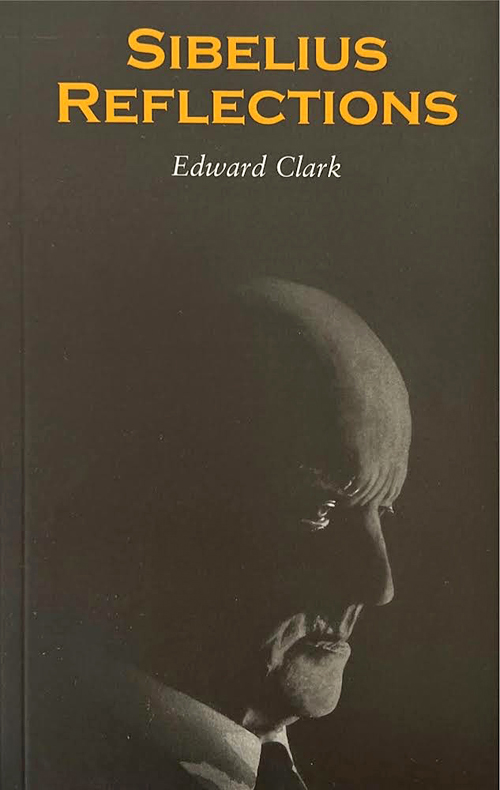
Sibelius Reflections by Edward Clark
Sibelius Reflections | £8
By Edward Clark
Edward Clark has been the President of the UK Sibelius Society since 1990. He was awarded the Sibelius Medal in 1992 and Knight of the Order of the Lion of Finland for services to Sibelius and Finnish music in 2018.
His book, published in 2006, combines a memoire of his love and admiration for Sibelius kindled at his school in the early 1960’s with an up-to-date biography and articles written for the society Newsletter over many years.
DISCOUNT OFFERS
4 CDs | £34
Schnéevoigt & Golschmann
Fougstedt
Koussevitzky
Jӓrnefelt
2 Books | £15
Santeria Levas: Jean Sibelius
Edward Clark: Sibelius Reflections
All Items | £46
P&P on all orders is £5 UK or £10 overseas
DOWNLOAD ORDER FORM
Download the ORDER FORM | PDF – will open a new page/tab.
(Please note that on mobile phones and tablets you will need a PDF reader app such as Adobe Acrobat Reader:
- iOS devices: Download from App Store
- Android devices: Download from Google Play)
MEMBERS MAY ALSO BE INTERESTED IN…
A comprahensive list of the Violin Concerto recordings
Members may be interested to read the long list, published by MusicWeb International, of recordings of the famous Violin Concerto. It lays claim to be the most recorded of all 20th century Violin Concertos. This list omits our issue of the commercial recording made by Janine Andrade, so the Society can take pleasure in adding value to this extensive catalogue.
Click HERE to read | PDF – will open a new window/tab
(Please note that on mobile phones and tablets you will need a PDF reader app such as Adobe Acrobat Reader:
- iOS devices: Download from App Store
- Android devices: Download from Google Play)
